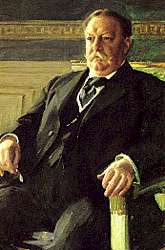William Howard Taft
From dKosopedia
Category: Presidents of the United States
|
William Howard Taft was the 27th President of the United States.
Contents |
Early Years
William Howard Taft was born in 1857, to a prominent family with roots in public service and law. His father, Alphonso Taft had a distinguished career in both, serving as a state judge from 1865 - 1872, U.S. Secretary of War in 1876, U.S. Attorney General from 1876 - 1877, and also serving as Minister to Austria-Hungary and Russia from 1882 - 1884 and 1884 - 1885 respectively.
Taft attended Woodward High School and finished second in his class, and followed family tradition by attending Yale, also finishing as salutatorian. He received his law degree from The Cincinnati Law School, later merging with the University of Cincinnati.
Public Service
Taft's public service began when he became Assistant Hamilton County Persecutor in 1881, followed by a job as Collector of Internal Revenue, and later State Superior Court Judge in Ohio by the age of 30. In 1890, he was made Solicitor General of the United States. Continuing his quick rise through the ranks of his profession, Taft was appointed as a judge of the Sixth U.S. Circuit Court of Appeals in 1892, serving on the court until 1900. During this time he was also Dean of the University of Cincinnati Law School, which had just merged with the school he graduated from. In 1901, William McKinley made Taft governor of the Philippines, to help with the transformation of the newly acquired islands from martial to civil law. It was during this time that Taft was admired for his ability as an administrator as well as a judge. When McKinley was assasinated in 1901, Theodore Roosevelt became President and recognized Taft's ability, making him Secretary of War in 1904. During his time as Secretary, his main job was overlooking the construction of the Panama Canal, which when successful made Taft popular with the media, praise which wouldn't last. It was also during this stint as Secretary that Taft would become good friends with Theodore Roosevelt.
His Presidency
Taft never wanted to be President. However, with the persuasion of his wife Nellie, and the friendship and endorsement of one of the nation's most charismatic men (Theodore Roosevelt), Taft easily disposed of the Democratic nominee William Jennings Bryan and became the 27th President of the United States. Despite his promises to continue Roosevelt's progressive reforms and "trust busting" during his campaign, Taft's presidency was a largely a failure due to his inability to unite the rival factions of the Republican Party, which was split between western progressives, who wanted more reforms, and eastern conservatives, who believed that Roosevelt had gone too far. He also broke promises to lower tariffs, by signing one that actually raised them, the Payne-Aldrich Tariff Act. This was combined by poor foreign policy that failed in reducing European control on Chinese markets and created hate in Latin America thanks to poor interventionism, especially in Nicaragua, where he sent Marines to quell a rebellion against an American Company's puppet government. That particular blunder would keep troops in Nicaragua for 21 years.
Loss of Popularity
Despite taking a tougher stance on big business than Roosevelt, (Standard Oil was dissolved in 1911) Taft was rejected by Roosevelt and the Progressives, who thought he had thrown away the hard work of the previous administration. Despite this animosity, the Republicans nominated him for another term, infuriating Roosevelt, who reentered politics and broke his supporters away into the "Bull Moose", or Progressive party, which created a three-way race that sent Woodrow Wilson to the White House. Taft only received 23 percent of the popular vote in 1912, the lowest of any presidential incumbent ever. He only carried two states, Vermont and Utah.
Post-Political Life
After his failed bid for reelection, Taft returned to what he loved most, law, becoming a professor at Yale and teaching for 8 years, until he was appointed as the ninth Chief Justice of the United States in 1921. He would serve until 1930, retiring shortly before his death that year.
Other Facts
A few notable facts not mentioned above include:
- Taft owned the first Presidential automobile and had the largest bathtub (he was our biggest president- weighing over 300 pounds and standing at over 6'2" tall).
- He was the first President to throw out the first pitch of the baseball year at the season opener in 1910.
- His wife was responsible for the Japanese cherry blossoms in Washington, D.C., planting the first saplings with the Japanese Ambassador's wife.
- He is one of two presidents to be buried at Arlington National Cemetary, along with John F. Kennedy.
External Links
| President of the United States of America |
| Washington • J Adams • Jefferson • Madison • Monroe • JQ Adams • Jackson • Van Buren • W Harrison • Tyler • Polk • Taylor • Fillmore • Pierce • Buchanan • Lincoln • A Johnson • Grant • Hayes • Garfield • Arthur • Cleveland • B Harrison • Cleveland • McKinley • T Roosevelt • Taft • Wilson • Harding • Coolidge • Hoover • F Roosevelt • Truman • Eisenhower • Kennedy • L Johnson • Nixon • Ford • Carter • Reagan • GHW Bush • Clinton • GW Bush • Obama |

![[Main Page]](../../../../upload/banner-blue-135.jpg)